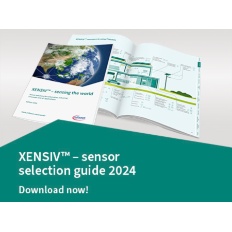Magnetic position sensors
Broadest range of magnetic position sensors for reliable and energy-efficient applications
Magnetic position sensors subcategories
Magnetic position sensors for reliable, energy-efficient applications
Infineon's magnetic position sensors with Hall sensing technology serve a range of purposes, from determining object proximity and detecting linear and rotational movement to measuring the angular position of a magnetic field. They can be used for motor control in BLDC motors, which can subsequently be used in home appliances and power tools. Our linear sensors come programmed with several interface options and report back extremely accurate linear and angular positional measurements.
Infineon’s XENSIV™ 3D magnetic sensors are an industry standard, able to three-dimensionally detect a magnetic field’s movement. They can be used in joysticks and gear shifts, as well as a magnetic rotary position sensor to control rotary knobs and indicators. Our magnetic angle sensors serve a number of automotive applications including measuring steering angle and torque, starting the motors of wipers, pumps, drives and actuators, controlling other safety, body, and powertrain features. Infineon's XENSIV™ sensors are exceptionally precise thanks to industry-leading magnetic technologies and over forty years of experience in sensing solutions.
Highly precise magnetic field and position sensing ICs
A magnetic position sensor observes an object and sends measurable data via a signal to convey its position. Use of this signal varies widely, as positional data can be used to trigger alarms, control system processes, and automate specific responses.
Magnetic position sensors are non-contact sensors, meaning they don’t need to make contact with the object they’re measuring in order to function, and therefore, suffer less wear and tear. In comparison to other types of sensors, they require fewer parts, making them easier to assemble and less likely to fail. Depending on the sensing capabilities of the magnetic position sensor ICs, the measurement technology falls into one of the following categories: anisotropic magnetoresistive (AMR), giant magnetoresistive (GMR), tunnel magnetoresistive (TMR), or Hall sensor technology.
Magnetoresistive sensors with AMR, GMR, & TMR sensor technology
With AMR, GMR, TMR, and Hall sensor technology offered as part of Infineon’s magnetic position sensor portfolio, manufacturers and designers can find the best-fit solution for their specific application.
Sensors with anisotropic magnetoresistive (AMR) technology creates a proportional magnetic field by sending electric current along a wire. The currents are sent through an equipped magnetic position sensor IC that uses permalloy, whose resistance is subsequently changed by the magnetic field. This is then converted into a measurable voltage.
Sensors with giant magnetoresistive (GMR) technology determines the amount of resistance by observing the degree to which magnetic fields are or aren’t parallel.
Sensors with tunnel magnetoresistive (TMR) technology accounts for two of its counterparts’ weaknesses: low voltage output and susceptibility to temperature changes. Thanks to their parallel structure, TMR sensors allow electrons to tunnel freely between their layers, creating an output several times higher than that of AMR or GMR sensors. Not only is it more powerful, but the tunneling effect results in accurate measurements unaffected by spikes or drops in temperature.
Magnetoresistive sensors with Hall effect sensor technology
Magnetic position sensors with Hall technology make use of the Hall effect, which creates a voltage by using a perpendicular magnetic field to distribute electric charges on opposite sides of a flat conductor. This distribution creates a potential difference known as Hall voltage that is directly proportional to the strength of the magnetic field.
A Hall sensor with a magnet in its shaft becomes attached to an object. As the object moves, its changing position affects the strength of the magnetic field being applied to the conductor. The converted Hall voltage is then used to show the location of the object.
Discover the different types of magnetic position sensors in our range
Magnetic position sensors are categorized by how they measure magnetic fields and what positioning and movement they determine. Their usage overlaps, but different sensors also have strengths that stand out in certain situations. Magnetic switches and linear sensors both work in concert with Hall sensor technology, which is responsible for measuring the strength and polarity of a magnetic field.
Magnetic switches are divided into switches and latches according to their switching behavior. Linear sensors are reliable and accurate pieces of equipment for detecting angular and linear object positioning. 3D magnetic sensors, on the other hand, are revolutionary due to their ability to not only offer contactless linear and angular detection, but more importantly, to determine a magnet’s movement in three dimensions as well.
Using Hall sensing technology, a 3D magnetic position sensor is designed to handle any kind of magnetic measurement, determining the strength of a magnetic field across x, y, and z axes. Finally, angle sensors operate with GMR, TMR, and AMR technology to determine sine and cosine angle measurements that reveal the positioning of a magnetic field.
Suitable for automotive, industrial, and consumer applications
Infineon’s range of magnetic position sensors mainly functions across automotive applications. Our 3D magnetic rotation sensors work in everything from navigation systems and wiper controls to gear stick and valve position sensing. Linear magnetic sensors are essential for safety features, regulating electric power steering, adjusting headlights, and serving as a magnetic throttle position sensor to balance the power flow to the engine. Angle sensors are used for sensing the steering angle, as well as measuring the rotor position.
Our Hall effect and magnetoresistive automotive position sensors are equally applicable to several other automotive applications, including magnetic crankshaft position sensors, which measure the position and rotation of an engine’s crankshaft. They also function as magnetic cylinder position sensors, which can be used to note and relay back the position of engine pistons. All Infineon's magnetic position sensors can be used across a range of industrial and consumer applications, such as brushless driver control (BLDC) motors, joystick components, robotics positioning control, as well as wearable and smart home devices.
Find information relating to the planned long-term availability of semiconductor products “Longevity” for Sensor products.
Download gallery documents
Fast finder
Welcome to our new interactive sensor selection tool, designed to connect you with the best fit for your design as quickly and effortlessly as possible. Simply select the overarching industry (automotive or industrial/consumer) and drill down on the applications till you find your target use case. The selection tool will then tell you what Infineon XENSIV™ sensor is the best choice for your design. It couldn’t be easier.












